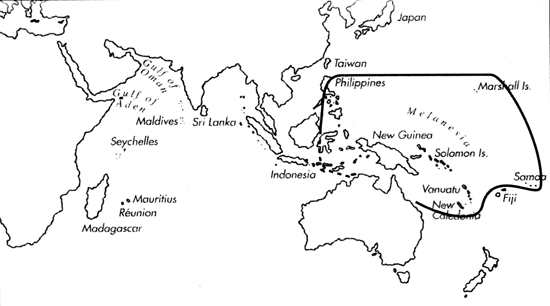Range: Indonesia and Philippines to Marshall Is.; Solomon Is., Queensland, New Caledonia, Vanuatu, and Samoa.
Description: Medium-sized to moderately large or large (New Caledonia), moderately solid to solid. Last whorl conoid-cylindrical, conical, ventricosely conical, ovate or cylindrical; outline varies from almost evenly convex to straight except for convex adapical fourth. Aperture wider at base than near shoulder. Shoulder subangulate to angulate, usually angulate in New Caledonian shells (Pl. 43, Fig. 19). Spire of low to moderate height, outline slightly concave, straight, sigmoid or variably domed. Early postnuclear whorls tuberculate but usually eroded. Teleoconch sutural ramps slightly concave, with a prominent subsutural ridge and 2 increasing to 5 weak spiral grooves, often obsolete or replaced by numerous spiral striae in late whorls. Last whorl with closely to widely spaced, prominent to weak spiral ribs on basal third.
| Shell Morphometry | ||
|---|---|---|
| L | 45-86 mm | |
| RW | 0.20-0.75 g/mm | |
| (L 45-80 mm) | ||
| RD | 0.48-0.61 | |
| PMD | 0.72-0.86 | |
| RSH | 0.07-0.15 | |
Ground colour white, suffused or clouded with pale pink, grey, blue, violet, or yellow. Last whorl with sparse to numerous brown blotches, flecks, spots, flames, axial streaks and axial lines, usually concentrated or fusing into 2 spiral bands above and below centre; shells with varied markings of all sorts intergrade with shells with sparse markings of only one type. Spiral rows of alternating white and brown dots, dashes and spots extend from base to shoulder but vary considerably; spiral rows sometimes lack white markings and are sometimes absent. Larval whorls white. Postnuclear sutural ramps with separate to fused, pale to dark brown radial blotches, streaks and lines often producing dark dots at outer margins. Aperture white or yellow deep within.
Periostracum pale brownish olive, thin, translucent, smooth.
In the Marshall Is., animal of white ground colour. Dorsum of foot mottled with brown, less so medially; anterior end nearly white at corners, with a triangular black blotch centrally; lateral and posterior marginal zones with brown to black radial blotches, well separated longitudinally on extended foot. Sole of foot sparsely mottled with light brown, ends almost immaculate, sometimes shaded with pink. Rostrum with dark brown and black longitudinal lines and streaks except for immaculate white tip. Siphon tipped with orange-red, then with a broad brown band; posterior half with brown markings confluent at base (Pearson, unpubl. observ.)(Pl. 82, First row).
Habitat and Habits: In 1-80 m; from lagoon pinnacles to the outer side of barrier reefs, living in sand pockets and caves, beneath rocks and on diverse reef substrate; in W. Samoa, in surf-zone under stones (Bayer, pers. comm., 1993). Reported to feed on small fishes and mollusks (Tirard, pers. comm., 1989).
Discussion: Specimens of C. floccatus with a colour pattern dominated by dark axial lines recall C. julii, but their last whorls are heavily clouded with various shades of violet and have prominent spiral rows of dark and white markings. Some shells of C. floccatus resemble C. circumcisus. The latter species attains larger size (L 55-100 mm), its pattern has prominent spiral bands of varying number but no dark axial lines on the last whorl, and its aperture lacks yellow colour. For comparison with C. richeri and C. gubernator, see the DISCUSSION of the latter species. C. magdalenae (Pl. 43, Fig. 20) refers to the yellow colour form of C. floccatus, and C. circumsignatus seems to be based on a subadult shell of the same shape and similar colour with prominent dark blotches and spiral rows on its last whorl.

C. floccatus range map
This section contains verbatim reproductions of the accounts of 316 species of Conus from the Indo-Pacific region, from Manual of the Living Conidae, by Röckel, Korn and Kohn (1995). They are reproduced with the kind permission of the present publisher, Conchbooks.
All plates and figures referred to in the text are also in Röckel, Korn & Kohn, 1995. Manual of the Living Conidae Vol. 1: Indo-Pacific Region.
The range maps have been modified so that each species account has it own map, rather than one map that showed the ranges of several species in the original work. This was necessary because each species account is on a separate page on the website and not confined to the order of accounts in the book.